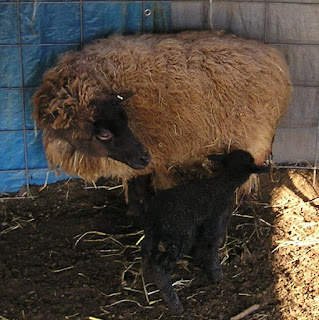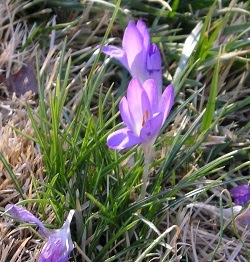News of Avillion
Friday, January 1, 2021
Cashmere, Cashgora, or Algora???
Last year when I discovered that our Alpine dairy goat had not gotten bred to the dairy goat buck I had leased early in the fall, I ended up breeding her with the only other available buck, which happened to be a fine fleeced white angora goat buck. Basically this was a way to bring her into milk; I assumed that the kids would either be adorable fuzzy weed eaters or suitable as dinner/bath rug. When the kids (doe, buck) were born on May 5, I was stunned at how soft and plushy they felt, in addition to being such a beautiful shiny white color. As they grew, they got ever fuzzier and by fall the little doe (Crosstitch) clearly need a trim as she was starting to develop mats and the fiber was about 4 inches long. With the assistance of a friend, I sheared her blanket area and put a coat on her. We combed her legs belly and neck fiber, but left the fiber to help her stay warm. I ended up with about 8 oz of fiber from that feels very soft and silky. The most similar fiber I can compare it to is suri alpaca, or silk. Her brother (Loomis) is similar in fiber type, but the fiber was perhaps 2 inches long in the fall. Using this fiber will be an interesting learning journey.
Friday, June 16, 2017
Muscovy Ducks in Springtime
The ducks start courting and mating as early as February some years. This year the courting got off to an early start because February was exceptionally warm. Courting usually involves the males preening their feathers and strutting around to attract female attention and then splitting off into harems. A relatively cool March and April slowed things down a little, but once May rolled around there were ducks on nests all over the farm. The ducks definitely have different styles in terms of where and how they like to nest, although many of them prefer the area of the rabbit barn because it is more protected and close to where they are fed. The following pictures illustrate different nesting styles.
This duck likes high sides and ground level, but is constantly annoyed when showered by rabbit urine. She tends to look up at the rabbit and make threatening noises, which the rabbit simply ignores. This choice of nesting area perplexes me, but this same duck does the same thing every year.
This duck likes high sides and ground level, and has made a better choice since she is not directly under the rabbits preferred urination area.
This duck has a good view and won't be bothered by rabbit showers, but gets terribly anxious whenever we are feeding or working with the rabbits. She also has to cope with her nest of hay being slowly eaten by the bunnies. When the eggs hatch it is also a long way down for the ducklings (luckily they bounce well).
This duck likes privacy with a ground level view and protection from the elements.
This duck makes a good choice far away from other ducks, rabbits and with a good view.
And of course we now have lots of ducklings wandering around.
Sunday, February 26, 2017
Shearing Day 2017
Due to an exceptionally warm February, we were able to get our bred angora does and bred Shetland ewes sheared on Saturday. The angora goats know what is up, and will glare at me as they await shearing their turn.
After we get started they generally relax, and it only takes about 10 minutes or less per goat. The fleeces came off very easily and were exceptionally clean this year.
After shearing we put sheep coats on the goats to help them stay warm. They also have heat lamps in their shelter.
The Shetland ewes tend to be very relaxed about being sheared (once caught that is). This year was very unusual in that all the adult Shetland ewes were already "on the rise." The rise is thought to be caused by changing seasons. During the winter, the wool growth slows down, causing a weak spot in the staple of the wool locks. In the spring, when wool growth resumes, the old wool thins and weakens where the new growth begins. Shetland sheep are best sheared slightly before or just when the rise is starting; shearing must be carefully timed to get the best quality fleeces.
The adult Shetland fleeces already well skirted, but will be given a final skirting before being used in our yarns and rovings, or sold as grease fleece.
The adult Shetland ewes were all snug in their barn this morning. The sheared goats were still wearing their coats. And everyone is looking very well. We'll be shearing last years lambs and kids, plus the Jacob sheep flock later in March and April.
Sunday, April 10, 2016
Lambs at Play
I just love watching the lambs at this time of year. Today we had our last Shetland lamb of the season born. A pretty little gulmoget ewe lamb to Prydwen. Of course the other lambs are just busy at play or else napping on mama. This year's lambs are mostly brown or white with many having gulmoget markings. The only exception being Lessie who had a dark little lamb that I believe will be emsket like her (dusky bluish gray).
Friday, March 11, 2016
First Shetland Lamb of 2016
On Monday, March 7, we went to do morning chores and got a fun surprise. Ceinwen, a white two-year old Shetland ewe, had a new lamb - a white ewe lamb that has among the most curious color markings I have ever seen. She is mainly white, but has one 4 inch black spot along her topline, brown shoulders, and brown stockings. Her mother is pure white with a few stray black spots on her face and her father is a white mirkface called Mojo who comes to us from Rarefind Farm in New Hill, NC. The three colors in one sheep is what makes her unique in my experience. She was a bit of a surprise because, her birth date indicates that the ram must have bred her mother the day he went in. This is unusual for me because typically the ewes are with the ram for a week to 10 days before they start to cycle and settle. Plus because Mojo was a ram lamb, I thought it might take him longer to get started; instead he turned out to be a very fast learner. In the picture below, we have Ceinwen and her lamb with Ceinwen's dam in the picture too.
Saturday, February 27, 2016
Lita Meets the Jacob Sheep
Last year our beloved diary goat Maelita finally had a doe and a buck kid; this is after 2 years of twin buck kids. We named her Lita as she is a smaller version of her mother, being half Nigerian Dwarf. Initially Lita was the soul of quiet politeness. Plus being so petite she is also incredibly cute. When she finally started to really grow, she became short, sturdy and very spunky - so much so that Maelita really did not like sharing quarters with her any longer. Since Maelita is due to kid in a couple of weeks, today we decided that it would be prudent to move her our of Maelita's stall and into the pasture with the Jacob ewes and their lambs - figuring that she would have plenty of company, and energetic lambs for playmates. Lita greeted the Jacob flock by running up to them intent on play, jumping into the air and galloping along sideways. The sheep fled in terror, which is when Lita decided that it would be a fun new game to run after the sheep.
However the Jacob reputation for cleverness is well deserved and they also have relatively low flocking instinct, which made it easy for them to separate out into multiple groups and thus Lita was only able to run after one group at once. Fortunately by evening Lita was finished with the fun and games (at least for now) and was busy eating hay along side a couple of lambs.
Tuesday, February 9, 2016
Spring Comes Slowly
Sir Walter Wally (NC's own groundhog) predicted an early spring. This was confirmed by the famous Pennsylvania groundhog.
I see signs of spring all around. We've got crocuses.
And dandelions.
And even some daffodils looking like they are getting ready.
And then there are the Jacob lambs. NC028-103 had twins (ewe, ram) early this morning. We're now up to 7 lambs from 4 ewes, with 6 ewes yet to lamb. But it still feels so cold outside and the lows are supposed to be in the 20s for the next few days.
Subscribe to:
Posts (Atom)






















